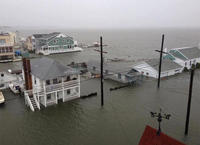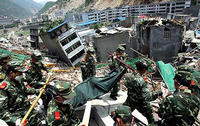-
Below Russian Far East there is a seismic hazards that could threaten Pacific Basin
For decades, a source of powerful earthquakes and volcanic activity on the Pacific Rim was shrouded in secrecy, as the Soviet government kept outsiders away from what is now referred to as the Russian Far East; research in the last twenty years, however, has shown that the Kamchatka Peninsula and Kuril Islands are a seismic and volcanic hotbed, with a potential to trigger tsunamis that pose a risk to the rest of the Pacific Basin
-
-
Fabric for military uniforms to repel chemical and biological agents
Military uniforms of the future may offer a new layer of critical protection to wearers; the fabric will be able to switch reversibly from a highly breathable state to a protective one in response to the presence of the environmental threat without the need for an external control system; in the protective state, the uniform material will block the chemical threat while maintaining a good breathability level
-
-
Mixing oil with dispersant increased toxicity to Gulf’s ecosystems
If the 4.9 million barrels of oil that spilled into the Gulf of Mexico during the 2010 Deep Water Horizon spill was an ecological disaster, the two million gallons of dispersant used to clean it up apparently made it even worse – fifty-two-times more toxic
-
-
Fracking in Michigan
In hydraulic fracturing, large amounts of water, sand and chemicals are injected deep underground to break apart rock and free trapped natural gas; though the process has been used for decades, recent technical advances have helped unlock vast stores of previously inaccessible natural gas, resulting in a fracking boom; researchers are examining the benefits of fracking for Michigan
-
-
Post-Sandy insurance rates increase may make coastal living unaffordable

Residents of New York and New Jersey are still coping with the destruction Hurricane Sandy caused, but home and business owners alike will soon face another burden: rising insurance rates and new building codes and requirements that could threaten many that live and work in the coastal areas of the two states
-
-
Lloyd’s says countries are under insured against natural disasters

Lloyd’s of London, the world’s largest insurance company, has warned seventeen countries that a $165 billion global insurance deficit leaves them vulnerable to long-term natural disaster costs; Lloyds says the world may not be able to afford another year like 2011, when natural disasters such as the earthquake and tsunami in Japan and the floods in Thailand caused $4.6 trillion dollars of damage to infrastructure, homes, and businesses, and which resulted in the largest disaster claims ever
-
-
The debate over radon as an earthquake predictor continues
Scientists have been interested in using radon emissions to predict earthquakes since the 1980s, but no solid evidence ever came to support it and the idea was abandoned by most in the field during the 1990s; now, scientists are looking again at radon as an earthquake predictor
-
-
Increase in negative messages about Muslims in the media: study

Organizations using fear and anger to spread negative messages about Muslims have moved from the fringes of public discourse into the mainstream media since the 9/ 11 attacks; to reach these conclusions, a University of North Carolina sociologist used textual detection software to track the influence of 1,084 press releases about Muslims from 120 organizations on more than 50,000 television transcripts and newspaper articles produced from 2001 to 2008
-
-
Hard choices to be made on adapting infrastructure to climate change
The costs of adapting to climate change, sea-level, and flooding include the upfront expenses of upgrading infrastructure, installing early-warning systems, and effective organizations, as well as the costs of reducing risk, such as not building on flood plains
-
-
Scientists identify a human-caused climate change signal in the noise
By comparing simulations from twenty different computer models to satellite observations, Lawrence Livermore climate scientists and colleagues from sixteen other organizations have found that tropospheric and stratospheric temperature changes are clearly related to human activities; “No known mode of natural climate variability can cause sustained, global-scale warming of the troposphere and cooling of the lower stratosphere,” says Livernore atmospheric scientist Benjamin Santer
-
-
Innovative method to capture CO2
The carbonate-looping method for capturing carbon dioxide (CO2) could reduce power-plant CO2 emissions by more than 90 percent, while utilizing less energy and incurring less expense than former approaches
-
-
Technology transfer from U.S. federal laboratories to private entities, other governments
In 2010 the eleven U.S. federal laboratories had more than 18,000 active collaborative relationships with private entities and other government agencies, disclosed more than 4,700 inventions, submitted 1,830 patent applications, and received 1,143 patents
-
-
Detection aircraft surveys 600 miles of PG&E California pipeline for gas leaks
PG&E’s transmission pipeline is routinely surveyed each year, typically by ground crews; accessing rural areas with difficult terrain, however, can be time consuming, expensive, and unsafe for crews on the ground; aerial surveys often look for dead vegetation as an indicator of gas leaks
-
-
Sea-levels rising faster than IPCC projections
Sea-levels are rising 60 percent faster than the Intergovernmental Panel on Climate Change’s (IPCC) central projections, new research suggests; the study involved an analysis of global temperatures and sea-level data over the past two decades, comparing them both to projections made in the IPCC’s third and fourth assessment reports
-
-
Synthetic fuels could entirely eliminate U.S. need for crude oil, create new economy

The United States could eliminate the need for crude oil by using a combination of coal, natural gas, and non-food crops to make synthetic fuel, a team of researchers has found; besides economic and national security benefits, the plan has potential environmental advantages; because plants absorb carbon dioxide to grow, the United States could cut vehicle greenhouse emissions by as much as 50 percent in the next several decades using non-food crops to create liquid fuels
-
More headlines
The long view
New Technology is Keeping the Skies Safe
DHS S&T Baggage, Cargo, and People Screening (BCP) Program develops state-of-the-art screening solutions to help secure airspace, communities, and borders
Factories First: Winning the Drone War Before It Starts
Wars are won by factories before they are won on the battlefield,Martin C. Feldmann writes, noting that the United States lacks the manufacturing depth for the coming drone age. Rectifying this situation “will take far more than procurement tweaks,” Feldmann writes. “It demands a national-level, wartime-scale industrial mobilization.”
How Artificial General Intelligence Could Affect the Rise and Fall of Nations
Visions for potential AGI futures: A new report from RAND aims to stimulate thinking among policymakers about possible impacts of the development of artificial general intelligence (AGI) on geopolitics and the world order.
Smaller Nuclear Reactors Spark Renewed Interest in a Once-Shunned Energy Source
In the past two years, half the states have taken action to promote nuclear power, from creating nuclear task forces to integrating nuclear into long-term energy plans.
Keeping the Lights on with Nuclear Waste: Radiochemistry Transforms Nuclear Waste into Strategic Materials
How UNLV radiochemistry is pioneering the future of energy in the Southwest by salvaging strategic materials from nuclear dumps –and making it safe.
Model Predicts Long-Term Effects of Nuclear Waste on Underground Disposal Systems
The simulations matched results from an underground lab experiment in Switzerland, suggesting modeling could be used to validate the safety of nuclear disposal sites.
